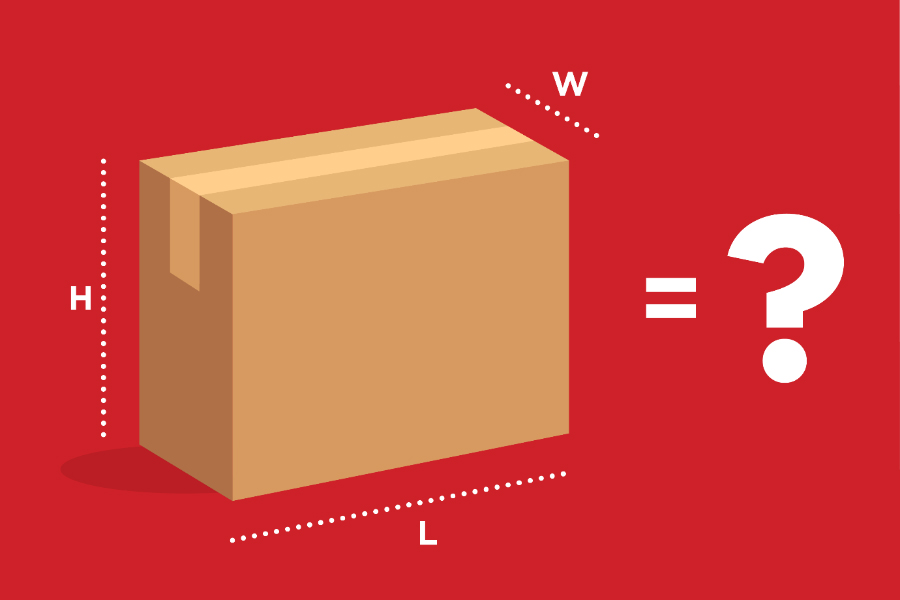[Updated post from January 21, 2021]
Shipping costs are consistently one of the biggest operational expenses for e-commerce merchants. For this reason, it's critical to understand how to keep these costs as low as possible - starting with dimensional (DIM) weight.
If your current packaging and shipping practices aren't catering to this pricing technique, your business is leaving a lot of money on the table that could go towards expanding your operation.
In this post, we're going to cover:
- Why carriers use dimensional weight
- How DIM pricing works
- How to calculate dimensional weight
- How partnering with a 3PL can help you to manage dimensional weight more effectively
What is dimensional weight?
Dimensional weight, also called DIM weight or volumetric weight, refers to a pricing method used by commercial freight companies and postal services. Put simply, dimensional weight calculates shipping costs according to the amount of physical space that a package occupies due to its cubic size.
By focusing on package density rather than just the actual weight of a parcel, DIM weight ensures that shipping carriers don't carry losses by shipping fewer packages at one time i.e. lightweight packages that take up more space.
All major carriers, including USPS, FedEx, and UPS, now use DIM weight charges for both domestic shipments and international shipments.
What is the difference between actual weight and DIM weight?
Actual weight refers to the weight of the package when it's placed on a scale. Actual weight is most commonly used to calculate shipping costs for small items that fit within carrier-supplied packaging i.e. flat-rate shipping services. Dimensional weight calculators measure the overall physical size of the package according to its cubic size. A freight carrier will create its own DIM weight charges according to the dimensional weight divisor it's using, so it's important to review rates carefully.
What is DIM pricing?
Dimensional weight pricing refers to how DIM weight is used to calculate the overall cost to ship a package with most shipping carriers. Dimensional weight takes into account a package's length, width, and height to determine billable weight. However, dimensional weight pricing is not used in every instance.
Dimensional weight pricing kicks in when the actual weight of the package is less than its DIM weight. Whatever is the greater of two will be used as the billable weight when calculating shipping rates.
For example, heavy and compact items like a set of dumbbells will have lower dimensional weight than their actual package weight. Therefore, DIM weight pricing is unlikely to come into play.
However, the shipping cost of large, relatively lightweight items such as artwork will be priced using DIM weight, because the space they can take up within a delivery truck is more significant.
This is why it's so important that businesses are using the correct-sized packaging for their products. Putting a small item within a large box not only increases the amount of packing filler you need to use, but also the package's dimensional weight, which leads to unnecessary shipping fees.
What is the DIM factor?
The DIM factor, or dimensional factor, is the divisor that freight carriers utilize to calculate dimensional weight. It represents the total volume of a package that is allowed per unit of weight.
It's important to be aware that the DIM factor used at one shipping carrier will not necessarily be the same as another; carriers will create their own dimensional weight calculator according to their own needs and service levels. For example, both UPS and FedEx use a DIM factor of 139 for their services, while USPS priority mail uses a DIM factor of 166.
Why is DIM weight pricing used by parcel carriers?
Freight carriers have long used dimensional weight to calculate shipping charges for air freight. Because space is at a premium on aircraft, package density i.e. the physical size of your package is taken into account in addition to its actual weight.
Yet dimensional weight is a relatively new pricing technique for ground shipping services. This is thanks in part to the rapid expansion of e-commerce that's taken place over the past decade and accelerated by the pandemic.
Since 2010, ecommerce has seen a remarkable 313% growth in revenue. As small parcel volumes surge, along with the demand for ever-faster delivery times, parcel carriers and freight companies are under increased pressure to maximize every inch of space within delivery trucks.
Moreover, the growing availability of free shipping has made it viable for consumers to rely on e-commerce for larger, big-ticket items, as well as removing the need to consolidate their purchases into fewer orders to reduce shipping costs.
To make sure they don't lose money in this shift towards smaller, more frequent orders, many major freight carriers have switched over to using DIM weight so they can charge for space rather than weight. This also helps encourage businesses to make their package dimensions as compact as possible, so providers can transport more parcels with each delivery round.
How to calculate dimensional weight
As mentioned above, finding the dimensional weight of a package requires calculating its physical size to determine whether this or the actual weight will be used as the billable weight.
Calculating dimensional weight requires the following steps:
- Multiply the length, width, and height of your package using the longest point of each side to calculate its cubic size. Thus should be rounded up to the nearest whole number. It's important to factor in any irregularities in the shape of the package, such as bulges or misshapen sides, as this could result in additional handling fees.
- Calculate the cubic size of a parcel by multiplying together the length, width, and height. For example, if you're shipping a package that measures 20 x 12 x 12 inches, your calculation would look like this:
20 x 22 x 12 = 2880 cubic inches
- To calculate DIM weight, you need to divide the parcel's cubic size by the dimensional weight divisor of the shipping carrier you're using.
Let's say that you're shipping with UPS, which uses a DIM factor of 139 for domestic and international shipments. If the package size is 2880 cubic inches, this is divided by 139. The resulting figure is the package's Dimensional weight:
2880 / 139 = 20.7
This figure must be rounded up to the nearest whole number, meaning 21 pounds is the dimensional weight of your package.
So, when is dimensional weight applied? If the actual weight of your package is less than its DIM weight of 21 pounds, then UPS or another shipping carrier will charge the dimensional weight. If the actual weight is higher, then this is the figure charged.
How a 3PL can help you manage dimensional weight effectively
As you can see, it's pretty easy to fall foul of dimensional weight calculations. Even when you understand dimensional weight charges, keeping pace with what it means for a complex SKU base and your packing process is incredibly time-consuming. Brands that fulfill orders in-house are more likely to fall foul of changing dimensional weight rules and miss out on effective ways to reduce DIM weight.
By partnering with an experienced e-commerce fulfillment partner like Ryder, your business is in a much more favorable position to manage dimensional weight effectively:
3PLs can negotiate affordable carrier rates
Because they ship such large parcel volumes, 3PLs are in a much stronger position to negotiate for lower shipping rates with parcel carriers, even for packages with higher DIM weights. This helps you to keep your overall shipping costs as low as possible.
Ryder also uses our in-house SmartRate Selection tool to rate shop between carriers in real-time, ensuring that you always have access to the very best prices.
3PLs know how to keep DIM weight down
Fulfillment providers are highly experienced in keeping both actual weight and package size as low as possible. Through advanced cartonization and streamlined packaging processes, 3PLs can tailor an order fulfillment strategy specifically to the characteristics of your SKU base to make sure that your business isn't paying more than it should for shipping.
3PLs are always keeping track of changes
DIM weight calculations are subject to change by the major carriers, and it's all too easy for merchants to get caught out if they aren't in the know. Fulfillment providers are always up-to-date that the latest industry changes, and can adapt their packaging strategies quickly to prevent your business from incurring unnecessary costs.
A nationwide omnichannel fulfillment provider with decades of proven experience in helping businesses keep pace with the dynamic retail landscape, Ryder, is a trustworthy partner who can ensure that your business is shipping orders effectively. Get in touch with us today to find out how Ryder can help to lower your e-commerce shipping costs.




